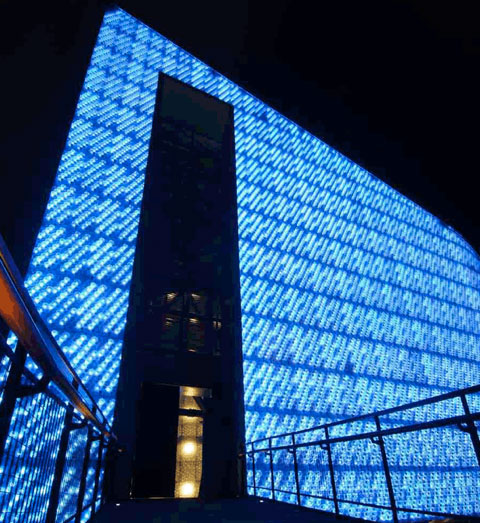Polli-Bricks Promises the Green in a Translucent Architectural Cladding
Apropos of the topic of refuse disposal, two enduring cinematic images come to mind. The first is the hapless Wall*E, negotiating the trash tower landscape of an abandoned earth, futilely squeezing the garbage into stackable cubits while occasionally salvaging a shred or two of treasure; the second is Andie MacDowell’s interview in Sex, Lies, and Videotape, wherein she departs from the topic at hand to express her atavistic consternation, “what will we do about all the trash?” And that was back in 1989. Today, amid murmurings of an ocean bespoiled with a Texas-sized isthmus of plastic bottles, any effort to invest this icon of refuse with even a smidge of functionality deserves serious investigation. So we owe it to Taiwan’s MINIWIZ to peer into the 8 liter volume of their Polli-Bricks building module. Made of recycled PET bottles, this carbon neutral building product may just be the stuff of our collective green dreams.
Polli-Bricks. Designed by MINIWIZ.
Affordability, Ecological Awareness, Translucent Transcendence
Polli-Bricks transcends several of the norms regarding cladding materials. The product is fully recycled. Each Polli-Brick is formed of a re-claimed and re-fashioned assortment of the ubiquitous (and ubiquitously discarded) plastic bottle. The unique eight-sided structure facilitates a self-interlocking assembly; thus, it’s extremely strong and about 1/5 of the weight of traditional curtain wall systems. Further, its translucence allows natural interior illumination, while its excellent insulative properties (each Polli-Brick houses eight liters of air, a proficient insulator) controls inside temps. Beyond pre- and post-production energy savings, the product is green in other ways too, not the least of which is local materials procurement. Says MINIWIZ principal Arthur Huang, “the construction process utilises locally collected recycled PET polymer bottles, so transport costs for construction materials are significantly reduced.”
The product has aesthetic advantages too. Its translucence gives it an intriguing, somewhat other-worldly and slightly retro appearance (similar to both the Beijing swimming cube, if I might take you back to the recent ancient history of 2008, as well as the cult toy “Lite Brite,” if I might take you back to the ancient ancient history of 1979). Polli-Brick’s affinity for both filtering and infusing light is enhanced by the product’s compatibility with LEDs. The modules’ flat sides are easily integrated with this functional darling of lighting design, thus “consolidating an all-in-one green energy lighting solution to continuously reduce the structure’s carbon footprint over time.”



Polli-Brick’s synthesis of cost savings, eco-consciousness, and functionality has drawn the deserved introspection alluded to above. The product recently won the 2010 Earth Award for best new Product, drawing out this acclaim from the judges, “the world’s first scalable carbon-neutral recycled polymer architectural cladding and is 100% re-engineered from recycled plastic bottles. The system includes solar-powered LED lighting, making any Polli-Brick structure a renewably energized and aesthetically pleasing architectural statement.”
The Polli-Brick is certainly an auspicious product with enormous potential, but any great aspiration can only benefit from a healthy dose of skepticism, so here’s my three cents worth of caveats: 1. Flammability—MINIWIZ says Polli-Bricks are “UV/Water proof sheet/fire proof”—but I’d like to know the details, given the decidedly undesirable prospect of a plastic building aflame; 2. Off-gassing—do the recycled Polli-Bricks no longer exhibit this potentially toxic phenomenon? How is the indoor air quality of a Polli Brick building? 3. Is the world ready for a plastic abode? A plastic workplace, sure, but how many of us are yet primed to embrace a homestead of the stuff?
Given that MINIWIZ had the foresight and determination to conceive of Polli-Bricks, I’m certain the answers to the former are both comprehensive and persuasive—and I’m eager to see the ongoing incarnations of this versatile new tool in the arsenal of international architecture.
Via Greenopolis.




Leave a Reply